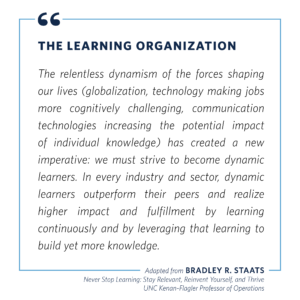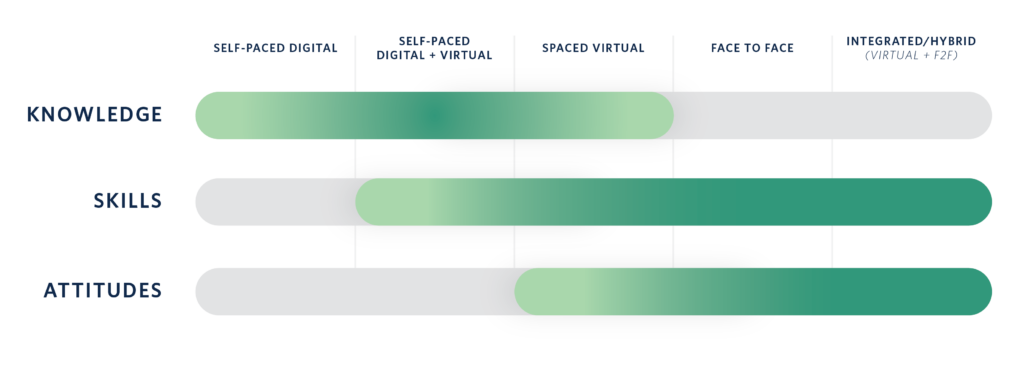Thought Leadership
Navigating the Pivot to Virtual Learning

Many organizations have undergone a range of digital transformation over the last five years. As the nature of work continues to change, learning and development (L&D) leaders must continuously evaluate how to support the evolving needs of their organizations. 
The need for organizations to change the way people learn was the top trend in Deloitte’s 2019 Human Capital Trends: 86% of respondents cited it as an important or very important issue. At UNC, we have seen greater adoption of principles supporting learning stickiness and a trend toward more self-driven and personalized development. L&D leaders are focused on rethinking paradigms of learning and are some of the most avid consumers of new technology. We are in the middle of a learning renaissance – an evolutionary change that is happening in some organizations faster than others.
Enter COVID-19
As a result of the COVID-19 pandemic, businesses and supply chains are navigating significant disruption. People are overwhelmed with drastic changes to both home and work routines. The pandemic has accelerated digital transformation already underway and, in some cases, is a forcing function for organizations still resisting change.
L&D leaders must have a pulse of their organization’s needs and craft a plan to effectively engage and develop their people for the future.
- Needs have changed. This has occurred on all levels: the organization, the individual and in leadership.
- Resources have changed. There is quite the spectrum of organizations doing really well versus those struggling, which could vary by industry. Some organizations have had to furlough their L&D department.
- Priorities have changed. Initiatives continue to shift as conditions change. Projects that had been on the back burner might now be top priority (such as the use of digital). What used to be most important might not make sense to focus on anymore, at least for the foreseeable future.
In response to the challenges created by the pandemic, L&D leaders have reported an increased interest in virtual learning and digital assets. But what is the right path to address immediate needs while also setting the organization up for long-term, sustained success? What are the impacts and implications of virtual learning?
In this environment, there is a heightened risk that short-term decisions could lead to a long-term negative impact on learning – and organizations certainly can’t afford to get this wrong. UNC recommends leaders carefully re-evaluate their learning and development strategy to account for the short-, mid- and long-term phases of this transformation – and weigh those choices against impact and implications.
The Pivot
As organizations challenge old paradigms and mindsets, L&D leaders are pivoting to continue to deliver learning and development opportunities. Since an in-person instructor-led format is not currently viable or realistic, L&D leaders have been forced to adjust format and delivery modality.
In response, some have performed a “lift and shift”: simply lifting existing programs and formats with no material change and shifting delivery to a virtual environment. This approach takes advantage of speed to market, but at what cost to quality and impact? Others have paused most, if not all, of their learning programs, and are re-assessing the organization’s needs and how to best meet those needs. They are focused on impact and effectiveness against redefined learning objectives.
During this time of disruption and change, L&D leaders need to slow down, understand the pivot and focus on the original intention of chosen initiatives, with careful consideration. Organizations must remain grounded in their “why” — that is the strong base of support for the pivot.
At UNC, our focus remains on achieving impact from the learning. We work with our clients to create strategic alignment, change leader behaviors, achieve desired culture change, help build leadership pipelines and strengthen succession plans, and accelerate transitions into new roles. This is our strong base of support.
“This crisis has scrambled many leaders’ previous thinking around strategy design and execution – earlier planning and prioritization might be moot, and the resources that were expected to execute that design could have been reduced or allocated elsewhere,” says Professor Dave Roberts, president of UNC Executive Development. So, it is imperative that L&D review and evaluate current plans and solutions, and re-assess objectives and expectations to meet the future needs of the business.
How to Pivot
Once the reassessment has occurred, the next step for L&D leaders is to think through “how” to deliver against the learning needs of the organization. The learning experience has to be different, and will continue to be different for an extended period.
At UNC, we weigh modality effectiveness against developing knowledge, skills and attitudes. The more complex the learning need, the more sophisticated the solution we design.
If the organization is embarking on a journey to affect attitudes around the company’s culture, self-paced digital assets will not be an effective solution. Self-paced digital assets can be a part of an integrated solution approach, but on their own, will not drive positive attitudinal change.
On the other hand, if the primary need is to create awareness by imparting knowledge about a particular subject, or to engage in just-in-time technical skill-building or refreshment, self-paced digital assets can be an effective and efficient modality. A collective focus should be on pairing the right solution to impact against the organizational needs.
UNC recommends different delivery modalities based on their effectiveness and efficiency – time, resources, investment – to address the objectives or outcomes desired by the organization. There are trade-offs for each. However, the best modalities for learning impact might not be immediately accessible in the near future.
Balancing effectiveness and efficiency against organizational needs, UNC works closely with clients to identify how and where to utilize different modalities and technology to meet the needs of the initiative and deliver impact. In these situations, when clients have afforded themselves the time to think first about the purpose of the learning, they can consider more innovative and creative learning solutions.

- Knowledge: Knowledge is the easiest competence to develop. Self-paced digital and live virtual are well-suited and should be highly utilized. This approach can be considered “just in time” and highly relevant. Combining self-paced digital and a live, virtual session and/or spaced virtual sessions is increasingly more effective at imparting and building knowledge. These modalities allow learners an opportunity to engage in deeper discussion with an expert, and hear from their peers in a cohort experience – providing the opportunity to build supportive networks for application in the flow of work.
- Skills: Effective skill development requires not only the imparting of best practices, but, most importantly, the opportunity to practice, receive real-time feedback, reflect and then practice some more. This is especially true for more complex leadership skills. Combining self-paced digital with live, virtual sessions provides opportunity and space for skill development. But depending on the skill, it might not be enough. Live, engaging and experiential learning sessions spaced over time – either virtual or face-to-face – support more effective skill development.
- Attitudes: Attitude change is much more complex, as effective change requires an emotional connection and sustained social support. This change typically happens following a compelling event or experience. Historically, these compelling experiences consisted of highly interactive discussion and activities in which learners are exposed to challenging situations that engage them to think and act differently. Effective attitude change is difficult to accomplish virtually, and requires a consistent, ongoing peer or coach engagement. This high level of engagement helps learners overcome potential obstacles, internal or external, when they apply new behaviors. Outcomes are achieved through sustained behavioral focus, practice and engagement.
Moving Forward
As organizations continue to navigate the ever-changing environment, it is critical to keep employees connected and continue to engage and develop learners as they prepare for the future. L&D leaders might choose, in this current state, to react and push digitally enabled content, but should do so with awareness of what needs might or might not be effectively addressed. Learning technology, platforms and digital assets should not be viewed as the solution, but as an enabler of the solution, to efficiently meet the learner where they are, contextualize learning, impart knowledge, reinforce skill building over time, and, ultimately, achieve impact.
UNC recommends that L&D leaders ask the right questions of their business partners to fully understand current and long-term needs, then be innovative enough in designing solutions to meet those needs and deliver impact for the organization. L&D leaders should take this opportunity to pause, inquire and advocate for the learners in their organization. Then evaluate the tradeoffs across different modalities and redefine learning objectives and expectations as necessary.
We encourage L&D leaders to consider the following questions when thinking through “what’s next” for their learning strategy and programs.
- How has the pandemic affected your learning and development strategy? What pre-existing programs and initiatives have been affected? How have the needs of the population(s) within your organization changed? What knowledge, skills and attitudes are critical for your leaders today compared to pre-pandemic?
- What do you want to accomplish in 2020-21? What will you focus on in the short-, medium- and long term?
- What challenges and constraints are you facing? Who are your reinforcing sponsors and how can they help address potential challenges or barriers?
- How open is your organization to virtual learning? How have expectations shifted because of working remotely? What has worked in the past? What has not worked?
- Which modalities should be leveraged to effectively address the needs of the organization?
- How will you measure impact of the learning experience?
Current expectations might differ from those held three months ago, and might again be different from expectations in 12 months. And we expect conditions, needs and solutions to change even more frequently going forward. Capabilities will adapt over time, and learning solutions will become more sophisticated as this accelerated transformation continues to evolve how and what we do.
Despite the uncertainty and ambiguity, we encourage L&D leaders to deeply understand the implications associated with short-term decisions and long-term impact. The choices you make today will determine the future success of your organizations and leaders.